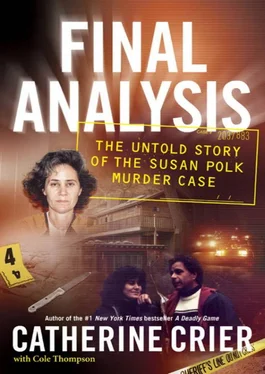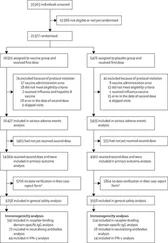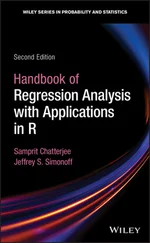“What size shoe do you use?” he asked the officer on redirect testimony.
“I use size 11,” Chamblee replied.
“Size 11? And that’s men’s?”
The officer smirked, eliciting laughter from the gallery and from jurors. “Yes, men’s.”
“Not that there’s anything wrong with it, but do you wear women’s shoes?” Sequeira asked.
“Not to work,” Chamblee grinned. His response brought a half smile to Susan’s lips.
Nevertheless, the day was not without its challenges. Susan caused a ruckus when she complained that the overhead projector or LMO, pronounced “ELMO,” that both sides used to display photos and other exhibits was blocking her view of Juror Number 10. Susan had been watching this juror and another female juror over several days, seemingly convinced the two were quietly conversing during the proceedings. During a break, and with jurors out of the courtroom, she insisted that Judge Brady change places with her so that Brady could see the way her view was being obstructed.
Ordering Susan to the other side of the courtroom, the judge reluctantly stepped down from the bench and sat at the defense table, continuing her remarkable tolerance for Susan’s antics. Still, she seemed more a ringmaster than an arbiter of the law as she worked to tame Susan. It was almost comical to watch the nearly fifty-year-old woman in the flowing black robe plop down in Susan’s chair and study the jury box.
“Can I sit in the jury box to show you what view I’m not getting,” Susan asked the judge.
“No.”
After sitting in Susan’s seat, Judge Brady determined that her view was fine. But Susan continued to argue, telling the judge that it was a serious violation of her rights if she couldn’t see the jurors’ faces and whether they were communicating with one another—which would be grounds for a mistrial.
“It will be moved after lunch,” Brady finally conceded.
Sequeira could not let the moment pass without voicing his objection. He told the judge that he had gone out his way to let Susan use the “ELMO” and to teach her and her assistant, Valerie, how to operate it. “Now she’s just trying to delay and control!”
“Objection!” Susan shot back. “Prosecutorial misconduct.”
Judge Brady closed her eyes and drew a deep audible breath. But the moment was quickly disrupted by Susan’s finger pointing. Now, she wanted Brady to punish members of the gallery for snickering.
“She’s just being obstreperous and obstructionist,” Sequeira barked, “for the record.”
“Prosecutorial misconduct,” Susan retorted, “for the record.”
Next on the stand was Sheriff’s Deputy Shannon Kelly. Kelly was the officer who drove Susan to police headquarters the night Felix’s body was discovered. He said that during the ride, Susan was “unemotional” and claimed to have no knowledge of Felix’s death.
“I didn’t do anything,” Susan allegedly told the officer during the ride. “Are you sure it’s my husband? Did my son identify the body? Because his car isn’t here.”
Susan jumped up when it was her turn to question the officer. “Do you think if you had someone who was under arrest, and was accused of murder, sitting in the backseat of your car crying, and you had the music on, that you could hear them crying?” she asked from the podium.
“I could, depending on how loud the music was.”
“Have you ever heard the expression ‘crying inside’?”
“No,” Kelly replied.
The following morning, March 24, Susan was brimming with complaints, but her latest grievance was not immediately clear to members of the court.
“I’ve informed the court of the harassment and outright brutality I’ve been subjected to while in custody,” she told Judge Brady. Judge Brady looked bewildered as Susan detailed her alleged confrontation more than two years earlier with a court officer. She claimed the deputy had pulled her from the courtroom and clubbed her on the elbow with a blackjack, thus breaking her arm.
“This incident has already been dealt with,” the judge advised Susan. “I believe the facts surrounding it are quite disputed, but anyway, what’s your point?”
“Instead of giving me medical treatment I was locked in a padded cell for hours,” Susan rambled on. “Denied painkillers for the broken arm…. I have been locked in cells with urine and feces on the floor, urine soaked mattresses, broken sinks.”
The judge was losing her patience and instructed Susan to “move it along.” Susan responded that she had been given “secret” information from an officer who claimed there was a conspiracy in the works. Susan was going to be “set up.” A deputy was going to claim that she attacked him, providing a reason to discipline and harm her, Susan told the judge.
“I want bail, or to be moved to another county,” Susan demanded.
Judge Brady was incredulous. “I can’t act on information based on unnamed sources about vague allegations on some future event,” she told Susan. “I need more evidence, statements from the officer, who has a legal duty to report that kind of information to his superiors.”
“I’m certainly not going to reveal my source,” Susan huffed. “This officer is trying to help me.” Again, Susan claimed that she didn’t feel safe and asked to be moved to another county.
When the judge denied her request, Susan angrily retorted, “Well, I’ve made my record.”
Sequeira was in court for the bizarre exchange but remained silent. Once the matter appeared resolved, he informed the judge of his problems with several witnesses. One was sick and unavailable to testify. He was having trouble finding accommodations for several others who had flown in earlier to testify and had gone home because of delays in the proceedings. Now, all the hotels in town were booked because of the NCAA basketball tournament at the arena in Oakland.
“I object,” Susan interjected. “This is a violation of my right to a speedy trial.”
Sequeira shot Susan a look, then asked the judge to instruct her not to discuss the State’s delays in front of the jurors.
But Susan exhibited her usual defiance and continued to voice objections.
“Mrs. Polk, DO NOT interrupt me again!” Judge Brady threatened.
To which Susan replied, “Well, you interrupted me.”
Susan was still ranting when the judge adjourned court for the weekend, stepped down from the bench and disappeared into the hallway. Proceedings would resume on Monday with testimony from more law enforcement officers. Among those scheduled to take the stand that week was the lead homicide detective, Mike Costa.
Chapter Twenty-five
FORENSIC FACTS
Of all the police officers on the case, Susan was most interested in Detective Mike Costa. Susan watched from the defense table as the thickset detective climbed into the witness box Tuesday morning. Costa had recently retired from the force and had been flown in from his new home 100 miles away to testify. His first order of business would be to address the videotaped late-night interview he conducted with Susan at police headquarters on October 15, 2002.
Susan tried to get the judge to suppress the tape, claiming that she had not been Mirandized before the interview. When that failed, she insisted that the detective should have halted the interrogation after she complained of being “very, very tired” and “showed obvious signs of shock.”
Judge Brady denied her requests. “There was a clear understanding of the rights and a clear waiver,” the judge told Susan during a sidebar that morning. “It was probably the gentlest interview I’ve ever seen in a homicide investigation.”
Jurors waited in the hushed courtroom as Sequeira cued up the videotaped recording of the two-hour interrogation. Susan was now sitting at a table adjacent to the jury box so that she could watch along with the panel. The lights had been dimmed and the vertical blinds on the two windows on either side of the judge were pulled shut for the presentation.
Читать дальше











